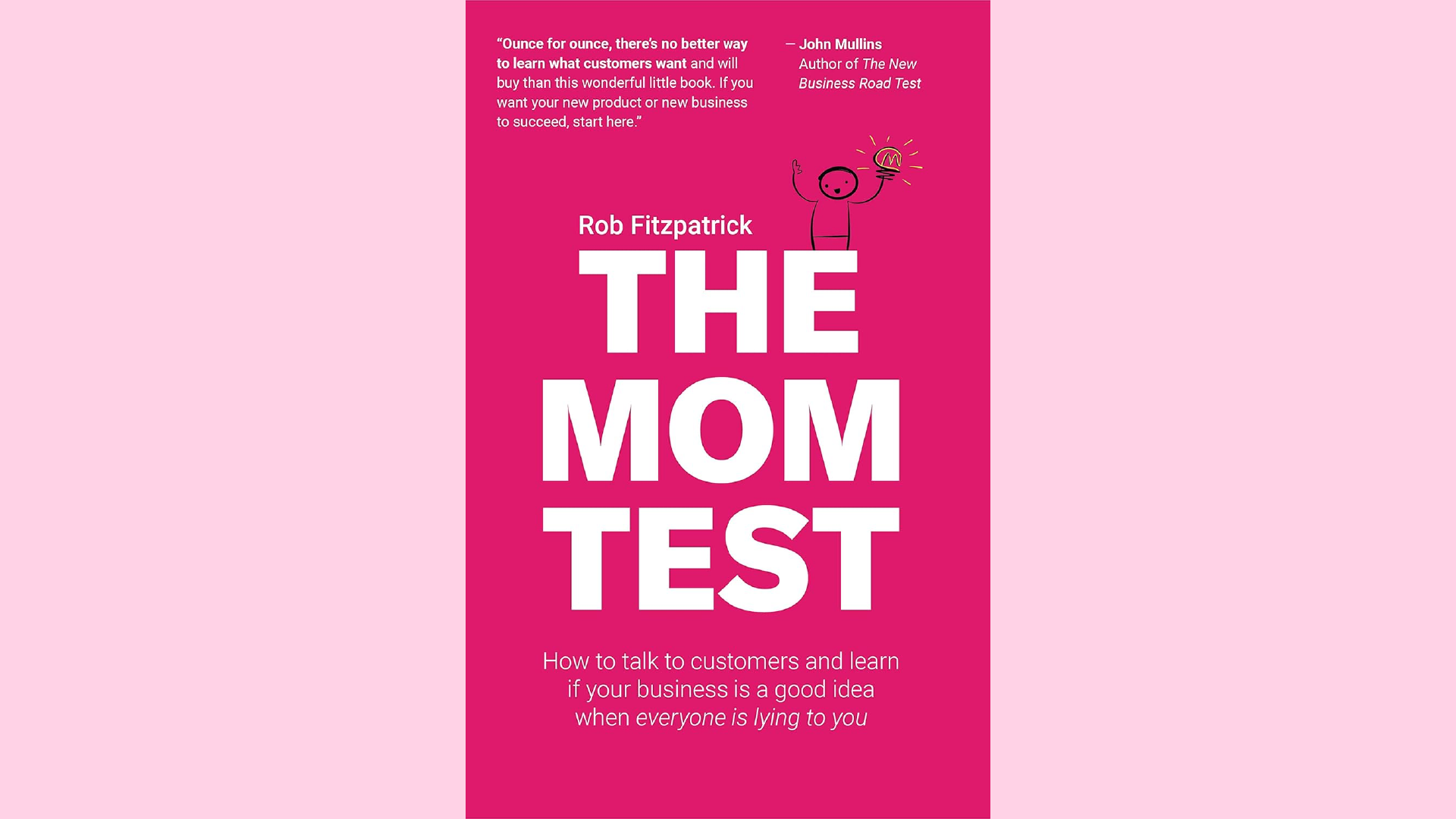Summary: The Mom Test by Rob Fitzpatrick

How Entrepreneurs Can Ace Customer Conversations: Lessons from "The Mom Test"
As entrepreneurs, mastering the art of conversation is as crucial as any other skill in your arsenal. Whether you're validating a new product idea or seeking feedback on an existing service, how you engage with potential or existing customers can make or break your business. Drawing from Rob Fitzpatrick's invaluable insights in "The Mom Test," here's a practical guide on transforming your customer conversations from mundane to meaningful.
Focus on Their Problems, Not Your Solutions
First and foremost, shift the spotlight from your product to the customer's experiences. When you discuss their life and issues rather than promoting your idea, you dodge the pitfall of biased affirmations. People are more likely to open up about genuine problems when they aren't feeling pressured to appease their entrepreneurial ego. Ask questions that delve into the specifics of their challenges. For instance, instead of asking, "Would you use a tool that organizes your emails?" you might ask, "How do you currently manage your email overload?"
Rob Fitzpatrick emphasizes, "You aren't there to pitch; you are there to learn about their pains, needs, and burning desires."
Cultivate Conversations, Not Interrogations
The essence of "The Mom Test" is to make your interactions feel like a chat over coffee rather than a formal survey. This casual approach fosters a relaxed environment where the conversation partner can share honest and natural responses. You extract authentic insights buried beneath surface-level politeness by keeping the dialogue light and friendly.
Listen More Than You Speak
As tempting as it might be to fill the air with your visions and ideas, listening is your most excellent tool. By actively listening, you allow the customer to provide the information that matters most to your business's success. The goal is to uncover their needs and the 'why' behind their actions. This often means biting your tongue and resisting the urge to solve their problems verbally immediately.
Fitzpatrick advises, "Good listening means letting them lead the conversation."
Dig Deeper with Follow-Up Questions
When a customer shares something intriguing, seize the opportunity to dig deeper. Follow-up questions help you navigate the conversation to uncover more detailed insights. For example, if a customer mentions they find your app interface overwhelming, you could follow up with, "What specifically about the interface do you find overwhelming?" This not only shows that you are listening but also that you care about their specific needs and experiences.
Value Stories Over Generalizations
Encourage your customers to share specific stories about their past experiences. This tactic is more revealing than asking for hypotheticals about future behavior, which can lead to speculative or idealized responses. Stories reveal patterns in behavior and decision-making that are gold for a wise entrepreneur.
"The strongest compulsion is the compulsion to keep consistent with one’s commitments," Fitzpatrick notes the importance of real user commitments over polite assurances.
Analyze and Act on the Data
After the conversation, take the time to organize and analyze the feedback. Look for patterns or repeated concerns that could indicate critical areas for improvement or innovation. This data-driven approach ensures that your decisions are based on user needs and not just assumptions.
Stay Prepared but Adaptable
While having a clear objective for each conversation is important, remain adaptable. Allow the natural flow of dialogue to introduce new topics that may provide unexpected insights. Sometimes, the most valuable feedback comes from questions you hadn’t planned to ask.
Conclusion
Applying these techniques from "The Mom Test" will significantly enhance the quality of feedback you receive from customer conversations. Remember, your goal isn't merely to confirm what you hope to be accurate but to discover what you need to know to succeed. As you refine your approach to customer interactions, you'll build better products and stronger relationships with those who use them.
This guide is designed to transform your engagement with customers, ensuring that every conversation brings you closer to a product that truly meets their needs.
Step-by-Step Guide to Testing an Idea with "The Mom Test" Approach
Introduction
Testing a business idea can be challenging, especially when well-meaning friends and family give positive, non-constructive feedback. "The Mom Test" by Rob Fitzpatrick provides a practical approach to getting honest and valuable feedback from potential customers. This guide will walk you through the steps to effectively test your idea using this method, ensuring you gain valuable insights and make informed decisions.
Step 1: Define Your Goal
- Objective: Understand your customers' problems and validate whether your idea solves a real need.
- Outcome: Clear insights into whether your idea addresses a significant pain point for potential customers.
Step 2: Identify Your Target Audience
- Who to Talk To: Select individuals who fit your target customer profile.
- Criteria: They should be potential users or have experienced the problem you aim to solve.
Step 3: Prepare Your Questions
- Focus on Problems: Frame questions around the customer's experiences and problems, not your idea.
- Avoid Hypotheticals: Ask about specific past behaviors and situations.
- Sample Questions:
- "Tell me about the last time you faced [specific problem]."
- "How do you currently solve [specific problem]?"
- "What are the biggest challenges you face with [specific problem]?"
Step 4: Conduct the Conversations
- Setting: Keep it casual and informal to make the interviewee comfortable.
- Tone: Focus on listening rather than pitching your idea.
- Structure:
- Start with a brief introduction of yourself and the purpose of the conversation.
- Ask open-ended questions about their experiences and challenges.
- Listen actively, take notes, and avoid leading questions.
- Probe deeper based on their responses to uncover more insights.
Step 5: Analyze the Feedback
- Patterns: Look for recurring problems and themes across different conversations.
- Pain Points: Identify the most common and severe problems mentioned by your interviewees.
- Insights: Note any surprising insights or new information that could affect your idea.
Step 6: Validate or Pivot
- Validation: If feedback consistently shows a significant problem your idea can solve, proceed with further development.
- Pivot: If feedback indicates your idea does not address a real need or there are more significant issues to solve, consider pivoting or refining your idea.
Step 7: Iterate
- Continuous Learning: Repeat the process with refined questions or a more focused audience as needed.
- Adapt: Use new insights to adapt and improve your product or idea continually.
Example Scenario
- Goal: Validate a new app idea for helping remote workers manage their time more effectively.
- Target Audience: Remote workers and freelancers.
- Prepared Questions:
- "Tell me about the last time you struggled to manage your work schedule."
- "What tools do you currently use to stay organized?"
- "What’s the most frustrating part of managing your time?"
- Conversations: Conduct informal interviews with 10-15 remote workers.
- Analysis: Identify common issues such as "difficulty in maintaining work-life balance" or "overlapping meetings."
- Validation/Pivot: Decide whether to continue with the app development based on the feedback.
- Iteration: Refine the app’s features based on new insights and test again if necessary.
Following these steps, you can effectively use the "Mom Test" approach to validate your business idea, ensuring it addresses real customer needs and avoids common pitfalls in customer conversations.

About Rob Fitzpatrick
Rob Fitzpatrick is a seasoned entrepreneur and author, best known for his book "The Mom Test," which tackles the challenge of learning from customers when everyone is lying to you. With a background in computer science from MIT, Fitzpatrick has co-founded multiple tech startups and has been actively involved in the startup scene, mentoring at accelerators like Seedcamp and speaking at conferences around the globe.
His founder experiences, including successes and failures, have imbued him with deep insights into the realities of starting and growing businesses, making him a sought-after advisor in the tech and business community. Fitzpatrick’s writing and lectures are not only based on sound theory. Still, they are also heavily informed by his practical experiences in the entrepreneurial trenches, where he has learned firsthand the importance of asking the right questions and listening carefully to your customers.
